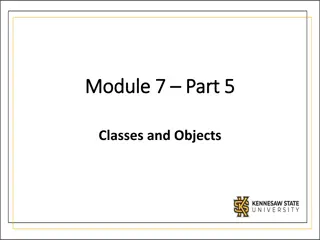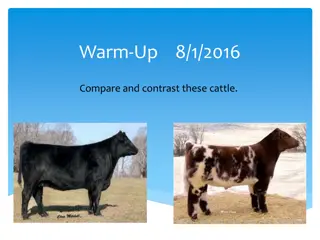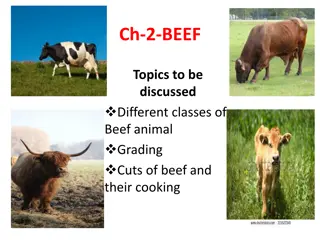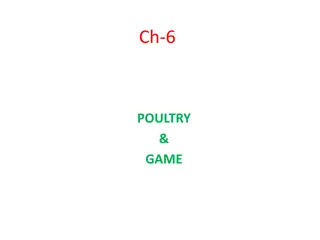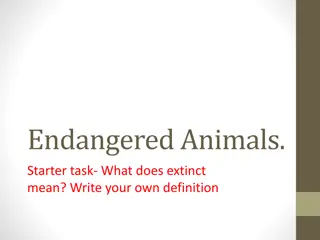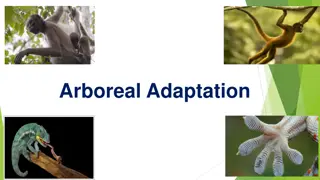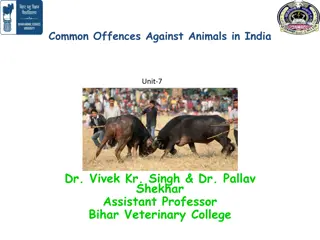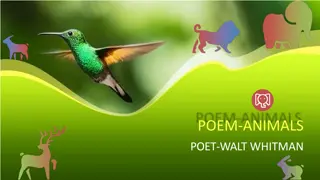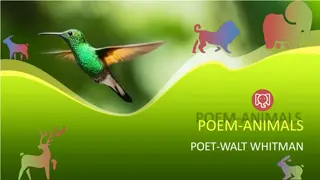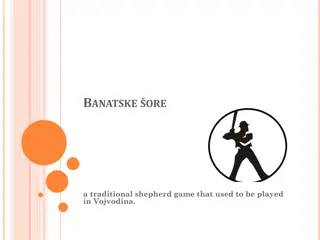Creating a Game: Classes for Animals Care
Exploring the concept of classes, inheritance, and interfaces, we delve into creating classes for animals in a game. From a simple Food class to detailed Elephant and Rabbit classes, we see how inheritance helps manage code efficiently while maintaining common attributes between different animal types.
Download Presentation

Please find below an Image/Link to download the presentation.
The content on the website is provided AS IS for your information and personal use only. It may not be sold, licensed, or shared on other websites without obtaining consent from the author. Download presentation by click this link. If you encounter any issues during the download, it is possible that the publisher has removed the file from their server.
E N D
Presentation Transcript
Classes Inheritance & Interfaces
Building "Animal Conserving" Imagine we're building a game where we take care of cute furry/ferocious animals: What would be the classes in this program?
A Food Class Let's start simple: class Food: def __init__(self, name, type, calories): self.name = name self.type = type self.calories = calories How would we use that class? broccoli = Food("Broccoli Rabe", "veggies", 20) bone_marrow = Food("Bone Marrow", "meat", 100)
An Elephant class class Elephant: species_name = "African Savanna Elephant" scientific_name = "Loxodonta africana" calories_needed = 8000 def eat(self, food): self.calories_eaten += food.calories print(f"Om nom nom yummy {food.name}") if self.calories_eaten > self.calories_needed: self.happiness -= 1 print("Ugh so full") def __init__(self, name, age=0): self.name = name self.age = age self.calories_eaten = 0 self.happiness = 0 def interact_with(self, animal2): self.happiness += 1 print(f"Yay happy fun time with {animal2.name}") def play(self, num_hours): self.happiness += (num_hours * 4) print("WHEEE PLAY TIME!") How would we use this class? el1 = Elephant("Willaby", 5) el2 = Elephant("Wallaby", 3) el1.play(2) el1.interact_with(el2)
A Rabbit class class Rabbit: species_name = "European rabbit" scientific_name = "Oryctolagus cuniculus" calories_needed = 200 def eat(self, food): self.calories_eaten += food.calories print(f"Om nom nom yummy {food.name}") if self.calories_eaten > self.calories_needed: self.happiness -= 1 print("Ugh so full") def __init__(self, name, age=0): self.name = name self.age = age self.calories_eaten = 0 self.happiness = 0 def interact_with(self, animal2): self.happiness += 4 print(f"Yay happy fun time with {animal2.name}") def play(self, num_hours): self.happiness += (num_hours * 10) print("WHEEE PLAY TIME!") How would we use this class? rabbit1 = Rabbit("Mister Wabbit", 3) rabbit2 = Rabbit("Bugs Bunny", 2) rabbit1.eat(broccoli) rabbit2.interact_with(rabbit1)
Notice similarities? Elephant Rabbit # Class variables species_name scientific_name calories_needed # Class variables species_name scientific_name calories_needed # Instance variables name age happiness # Instance variables name age happiness # Methods eat(food) play() interact_with(other) # Methods eat(food) play() interact_with(other) Elephant and Rabbit are both animals, so they have similar attributes. Instead of repeating code, we can inherit the code.
Inheritance In object-oriented programming, inheritance is where one class is derived from another class. The derived (child, or sub-) class has all the attributes and methods of the base (parent or super-) class. It can then add new attributes and methods and also override methods from the parent.
Base classes and subclasses When multiple classes share similar attributes, you can reduce redundant code by defining a base class and then subclasses can inherit from the base class.
The base class class Animal: species_name = "Animal" scientific_name = "Animalia" play_multiplier = 2 interact_increment = 1 calories_needed = 0 def eat(self, food): self.calories_eaten += food.calories print(f"Om nom nom yummy {food.name}") if self.calories_eaten > self.calories_needed: self.happiness -= 1 print("Ugh so full") def __init__(self, name, age=0): self.name = name self.age = age self.calories_eaten = 0 self.happiness = 0 def interact_with(self, animal2): self.happiness += self.interact_increment print(f"Yay happy fun time with {animal2.name}") def play(self, num_hours): self.happiness += (num_hours * self.play_multiplier) print("WHEEE PLAY TIME!") What has changed?
The subclasses To declare a subclass, put parentheses after the class name and specify the base class in the parentheses: class Panda(Animal): Then the subclasses only need the code that's unique to them. They can redefine any aspect: class variables, method definitions, or constructor. A redefinition is called overriding. The simplest subclass overrides nothing: class AmorphousBlob(Animal): pass But this is rarely the case or you wouldn't need a subclass!
Overriding class variables Subclasses can override existing class variables and assign new class variables: class Rabbit(Animal): species_name = "European rabbit" scientific_name = "Oryctolagus cuniculus" calories_needed = 200 play_multiplier = 8 interact_increment = 4 num_in_litter = 12 class Elephant(Animal): species_name = "African Savanna Elephant" scientific_name = "Loxodonta africana" calories_needed = 8000 play_multiplier = 4 interact_increment = 2 num_tusks = 2
Overriding methods If a subclass overrides a method, Python will use that definition instead of the superclass definition. class Panda(Animal): species_name = "Giant Panda" scientific_name = "Ailuropoda melanoleuca" calories_needed = 6000 def interact_with(self, other): print(f"I'm a Panda, I'm solitary, go away {other.name}!") How would we call that method? panda1 = Panda("Pandeybear", 6) panda2 = Panda("Spot", 3) panda1.interact_with(panda2)
Using methods from the base class To refer to a superclass method, we can use super(): class Lion(Animal): species_name = "Lion" scientific_name = "Panthera" calories_needed = 3000 def eat(self, food): if food.type == "meat": super().eat(food) How would we call that method? bones = Food("Bones", "meat", 50) mufasa = Lion("Mufasa", 10) mufasa.eat(bones)
More on super() super().attribute refers to the definition of attribute in the superclass of the first parameter to the method. def eat(self, food): if food.type == "meat": super().eat(food) is the same as: def eat(self, food): if food.type == "meat": Animal.eat(self, food) super() is better style than BaseClassName, though slightly slower.
Overriding __init__() Similarly, if we override __init__() in our subclasss, we need to explicitly call super().__init__() if we want to call the __init__ functionality of the base class. class Elephant(Animal): species_name = "Elephant" scientific_name = "Loxodonta" calories_needed = 8000 def __init__(self, name, age=0): super().__init__(name, age) if age < 1: self.calories_needed = 1000 elif age < 5: self.calories_needed = 3000 What would this display? elly = Elephant("Ellie", 3) elly.calories_needed # 3000
Object base class Every Python 3 class implicitly extends the object class.
Adding layers of inheritance But we can also add in more levels ourselves.
Multiple inheritance A class may inherit from multiple base classes in Python.
Inheriting from multiple base classes Then we inherit from them by putting both names in the parentheses: class Rabbit(Prey, Herbivore): class Lion(Predator, Carnivore):
Interfaces A common use of inheritance (single or multiple) is to provide a common interface to a group of classes. the Animal class provides the eat(), play(), and interact_with() methods the Predator class might provide a hunt() method the Prey class might provide an evade() and/or hide() method The base class may not (and often doesn't) provide an implementation of the provided methods Rather it just defines the methods' signatures, and then any function using an object of a class derived from the base class knows that it can expect that function to be there. Python is a little loose on this, but many other languages strictly enforce it. If a method doesn't have a definition, you can't create objects of that class.
Relying on a common interface If all a group of objects implement a method with the same function signature, a program can rely on that method across instances of different subclasses. def partytime(animals): """Assuming ANIMALS is a list of Animals, cause each to interact with all the others exactly once.""" for i in range(len(animals)): for j in range(i + 1, len(animals)): animals[i].interact_with(animals[j]) How would we call that function? elly = Elephant("Elly", 5) pandy = Panda("PandeyBear", 4) scar = Lion("Scar", 12) jane_doe = Rabbit("Jane Doe", 2) partytime([elly, pandy, scar, jane_doe])
Checking identity exp0 is exp1 evaluates to True if both exp0 and exp1 evaluate to the same object mufasa = Lion("Mufasa", 15) nala = Lion("Nala", 8) mufasa is mufasa mufasa is nala mufasa is not nala nala is not None # True # False # True # True
Composition An object can contain references to objects of other classes. What examples of composition are in an animal conservatory? An animal has a mate. An animal has a mother. An animal has children. A conservatory has animals.
Referencing other instances An instance variable can refer to another instance: class Animal: def mate_with(self, other): if other is not self and other.species_name == self.species_name: self.mate = other other.mate = self How would we call that method? mr_wabbit = Rabbit("Mister Wabbit", 3) jane_doe = Rabbit("Jane Doe", 2) mr_wabbit.mate_with(jane_doe)
Referencing a list of instances An instance variable can also refer to a list of instances: class Rabbit(Animal): def reproduce_like_rabbits(self): if self.mate is None: print("oh no! better go on ZoOkCupid") return self.babies = [] for _ in range(0, self.num_in_litter): self.babies.append(Rabbit("bunny", 0)) How would we call that function? mr_wabbit = Rabbit("Mister Wabbit", 3) jane_doe = Rabbit("Jane Doe", 2) mr_wabbit.mate_with(jane_doe) jane_doe.reproduce_like_rabbits()
Composition vs. Inheritance Inheritance is best for representing "is-a" relationships Rabbit is a specific type of Animal So, Rabbit inherits from Animal Composition is best for representing "has-a" relationships A conservatory has a collection of animals it cares for So, a conservatory has a list of animals as an instance variable


























